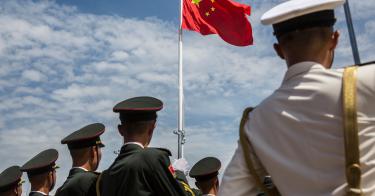An early lesson emerging from China’s handling of the COVID-19 emergency is that Beijing still manipulates data to fit its desired narrative. This has long been the case in China’s defense budget, where the party-government omits and withholds data to project a non-threatening image of its People’s Liberation Army. However, there are ways to cut through some of the mangled information.
If you account for differences in reporting structure, purchasing power, and labor costs, you find that China’s 2017 defense budget provided 87 percent of the purchasing power of American’s 2017 defense budget.
This runs counter to the conventional wisdom that the United States spends more on its military than the next 12 countries combined or that China lags annual U.S. military spending by close to $400 billion. Those misleading comparisons are based on simply converting Beijing’s reported defense budget from yuan to dollars by applying a market exchange rate. That produces a distorted picture. We must take into consideration several key factors to arrive at an accurate understanding of just how much Beijing is investing in its military.
One key factor—and perhaps the main one that makes accurate comparison so challenging—is how Beijing accounts for its military research and development. Put simply, it doesn’t include it in any of its reports on military expenditures.
Further complicating accurate comparisons are the unique characteristics of China’s party-run military, such as military-civil fusion, usage of state-owned enterprise, theft of intellectual property, and the embedding of party organizations in private companies. Some of these elements, even if known, are simply unquantifiable. Thus if we seek to compare the resources Beijing dedicates to defense with what other countries are doing, our only recourse it so remove all military R&D from the calculations.
Now, about those exchange rates… Multiple studies have validated the use of purchasing power parity, or PPP, to get a better picture of how global defense budgets compare to one another. PPP is a great tool designed for normalizing the costs of goods and services across borders. It is a good proxy for the material necessary to build tanks, bullets, meals, and other basic services for the military.
However, it is not a good index for military labor costs. A far better proxy is reported government employees’ salaries. We can compare government salaries in China to government salaries in the U.S. to get an approximate measure of how labor costs compare between the two countries.
Taking all these factors in consideration, when we examine the 2017 data we find that the People’s Liberation Army budget can buy the equivalent of 87 percent of the Pentagon’s budget. This explains how Beijing can afford an active force 2 million vs. United States’ 1.3 million. It is how the PLA Navy can commission about 14 ships each year, while the U.S. Navy commissions around five.
In the Cold War-era, multiple departments in the intelligence community were dedicated to understanding the Soviet defense budget and what it meant for the United States. Last year, the U.S.-China Economic and Security Review Commission’s annual report and the Defense Intelligence Agency’s China Military Power analysis dedicated a combined five pages to the Beijing’s defense budget with no discussion of any independent estimates’ methodology.
If we, as a country, are going to be able to compete effectively with the Peoples Republic of China, we need to understand it better. A great step towards better understanding is to assess accurately how it resources its military.
Right now, we are very limited in our public knowledge of China’s defense budget. After all, counting on Beijing to publish accurate data is a proven failed strategy.
This piece originally appeared in Defense One



